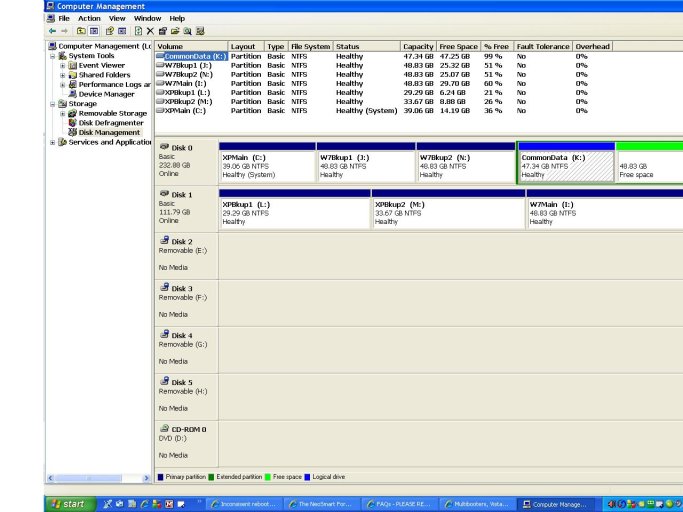Yikes!!! After several days of trying to find a pattern, have not discovered one. One an XP partition begins to reboot after getting to the Welcome screen, it will continue to do so from then on. If I then boot into a Windows 7 partition and from there restart and boot into an XP partition it successfully boots for one or more times, but never more than 3 times, then the rebooting begins during the Welcome screen. This inconsistency occurs whether using ntldr or easyldr.
I wonder if something is change the files during booting?
I have also have a question on the boot.ini files. I will attach the appropriate files to this reply. When I look at the boot.ini, for any of the 3 XP partitions, the partitions for rdisk(1) seem to be off by one, when compared to the computer management chart. However booting using this boot.ini works and find the correct C: drive when I can get the partition to boot. If I manually edit the boot.ini to match the computer management chart, then booting from rdisk(1) partition(1) actual boots from the drive shown as rdisk(1) partition(2). If I manually edit the boot.ini to match the computer management chart, then booting from rdisk(1) partition(2) returns a boot error. If I use a tool like GPARTED, it shows the partitions as hbb1: W7Main; hdb2: XPBkup1; hdb3: XPBkup2. It seems that the Computer Management chart is misleading, or I do not understand it.
Another thing the Computer Management chart show is XPMAIN is the active partition, which I expect, but W7Main is labelled boot.
Any help or information would be very helpful. If nothing abnormal is discovered, I will completely rebuild all 7 partitions and look for an alternative boot manager.
Again, thanks so much for your time and efforts.
I wonder if something is change the files during booting?
I have also have a question on the boot.ini files. I will attach the appropriate files to this reply. When I look at the boot.ini, for any of the 3 XP partitions, the partitions for rdisk(1) seem to be off by one, when compared to the computer management chart. However booting using this boot.ini works and find the correct C: drive when I can get the partition to boot. If I manually edit the boot.ini to match the computer management chart, then booting from rdisk(1) partition(1) actual boots from the drive shown as rdisk(1) partition(2). If I manually edit the boot.ini to match the computer management chart, then booting from rdisk(1) partition(2) returns a boot error. If I use a tool like GPARTED, it shows the partitions as hbb1: W7Main; hdb2: XPBkup1; hdb3: XPBkup2. It seems that the Computer Management chart is misleading, or I do not understand it.
Another thing the Computer Management chart show is XPMAIN is the active partition, which I expect, but W7Main is labelled boot.
Any help or information would be very helpful. If nothing abnormal is discovered, I will completely rebuild all 7 partitions and look for an alternative boot manager.
Again, thanks so much for your time and efforts.

